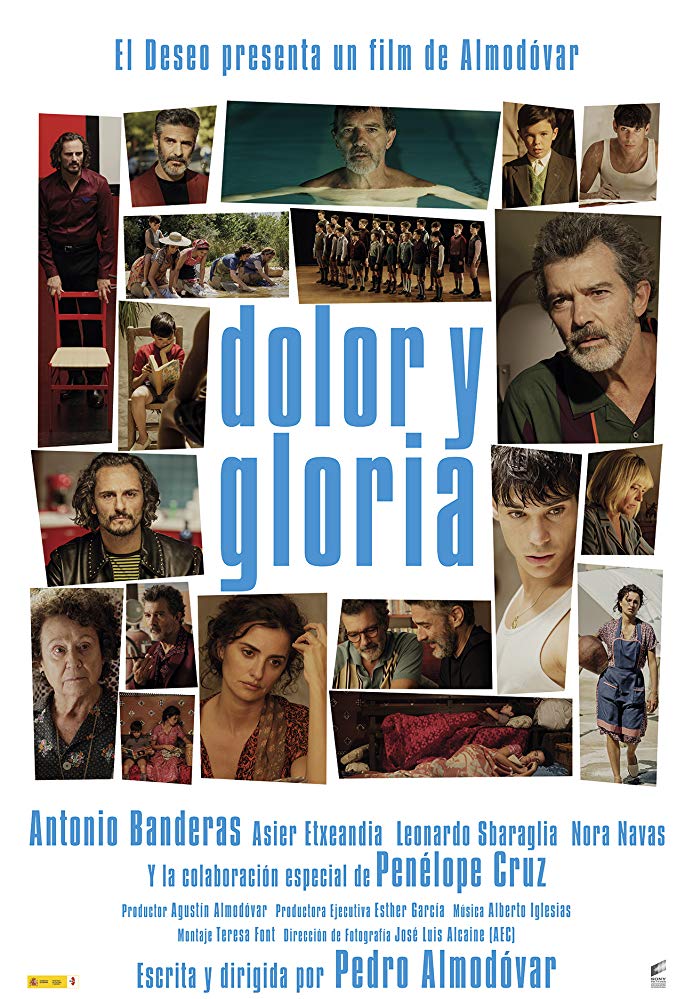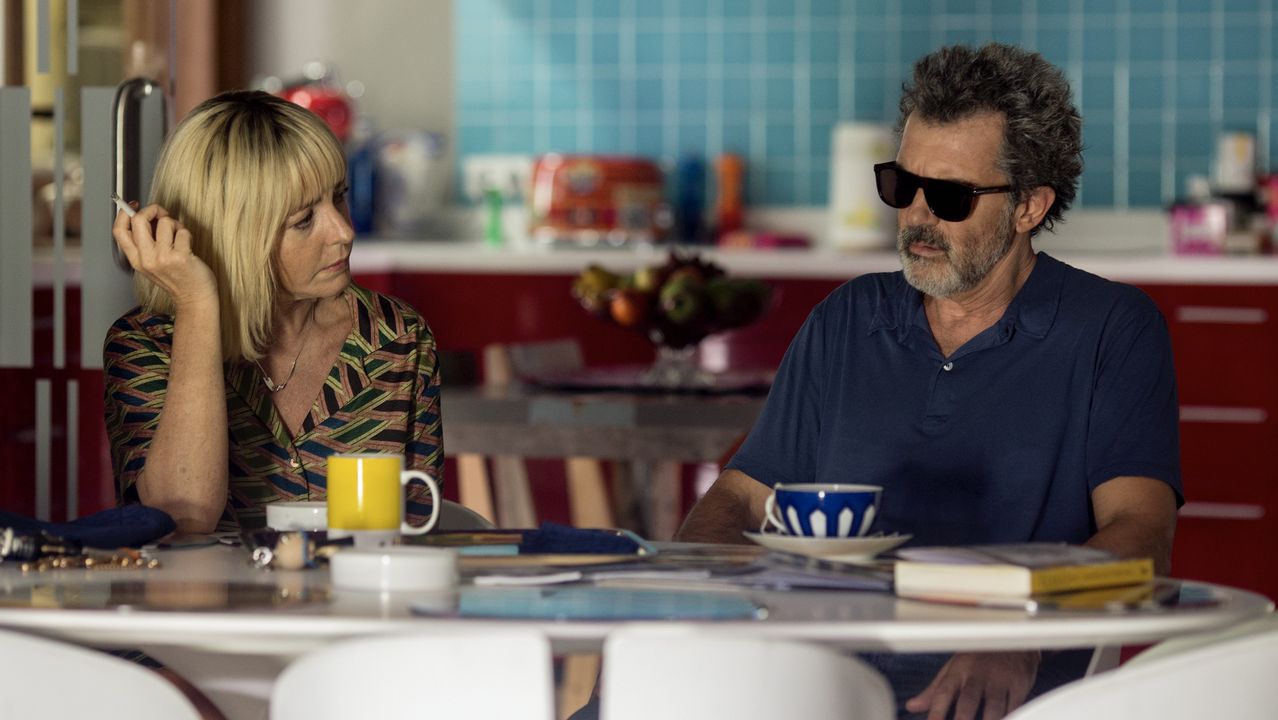“DOLOR Y GLORIA” AND THE PAIN OF ART

Pedro Almodóvar’s new film is a semi-autobiographical piece that follows Salvador Mallo (Antonio Banderas), a film director who finds himself in a sort of mid-life crisis both creatively (he hasn’t been able to make a film in years), physically (he suffers of many ailments) and emotionally (his mother recently passed away). It is in this vulnerable situation where he has to deal with ghosts from his past: the betrayal by an old friend and collaborator, actor Alberto Crespo (Asier Etxeandía); his relationship with his recently deceased mother and his ex-lover Federico with whom he shared a tumultuous relationship.
When we first meet Salvador, he is in pain: his back hurts, he suffers from migraines, depression and, just recently, he has started to easily choke on anything he eats. He is broken, hurt and lost. He gets a call from the Spanish Cinemateque, where he is invited to talk about his old film,- “Sabor”. In preparing for the talk, he rewatches the film and is pleasantly surprised. For many years he had hated that film, as he thought that Alberto Crespo’s performance was not what he expected for his protagonist. This caused a great fight between the two, which lead to them not speaking to each other for over thirty years. As he rewatches “Sabor”, however, he finds himself greatly enjoying his performance choice and questioning his long-time resentment.
Salvador visits Alberto and tries to make amends. They rekindle their friendship while smoking some heroin. In this newfound friendship, Alberto gives Salvador drugs in order to help him deal with his pain. In return, Salvador allows Alberto to use one of his texts for a performance. It is a monologue that shares the story of Salvador and his relationship with Federico who he ended up leaving due to his drug problems. Fate might have it that Federico is in Madrid during one of Alberto’s performances and, when he listens to the story, he clearly identifies with it. Overwhelmed, he pays Salvador a visit. They both spend the night talking and end up giving their relationship a closure that they never had.
The film often jumps backwards (or sideways, as we learn later) to a young Salvador and his relationship with his mother, Jacinta (Penélope Cruz), who, following her husband (Raúl Arévalo), moves her family to the caves in Paterna. This move does not make her happy, but she hopes to be doing what is best for her family. It is there that Salvador meets Eduardo, a young builder who will help them make their cave look more homely in exchange for Salvador teaching him how to write. One day, when Eduardo is finishing up, he sees Salvador siting on a chair while reading under the sunlight that shines down on the cave. Eduardo asks him to sit still while he draws him. When he is done, Salvador, who is not feeling well, decides to lie down. Meanwhile, Eduardo decides to clean himself up. When Eduardo asks him for a towel, Salvador, who finds himself in a feverish state, brings it to him. He sees Eduardo naked, drops the towel and faints.

As Salvador goes through this emotional rollercoaster, he finally decides to address his medical issues seriously. He decides to abstain from heroin and visits a doctor, who lets him know that the reason he is choking on food can be solved by a simple procedure and his pains can be managed by a change in medication. It is during this transition where he confesses to his assistant (played by the always wonderful Nora Navas) that he is haunted by the last moments he spent with his mom. The film flashes back a few months to an older and very different version of Salvador’s mom, Jacinta (played by Julieta Serrano) as she tries to get ready for her death with the help of her son. These scenes are, by far, my favourite part of the film. They are beautifully written and they allow the viewers to see the complicated relationship these two must have had. Jacinta tells Salvador that he hasn’t been a good son. “I haven’t?”, he asks, surprised. She lets him know she and her friends resent how he portrays them in film. Salvador doesn’t understand why, as he has always tried to portray his mother and the women who helped raise him with the utmost love and respect. This conflict between generations really spoke to me. These unspoken emotions that are finally revealed after all these years, those misunderstandings. It is said that beauty is in the eye of the beholder. The same can be said about words, actions and their meaning.
Back in the present, in a satisfying full circle moment, Salvador is surprised to find the same drawing that Eduardo made all those years ago in a small gallery. He decides to purchase it but can’t find where the maker is: the drawing was purchased in a flea market in Barcelona. This memory of the past, however, as well as his closure with friends and mother, seems to have healed him. In a final flashback we see young Salvador and his mother in a train station getting ready to move from the countryside. The camera pans out, though, and we see someone holding a microphone above Penélope Cruz and the young boy. We are in a movie set. As Salvador yells cut, we see him smile. He is finally making movies again. Having faced his ghosts, he is able to create again.
Fans of Almodóvar will probably be trying to decipher the autobiographical part of this film. Personally, however, I found it much more interesting to study his reflections on creative process. When the film starts, Salvador is having a hard time writing. He hasn’t filmed in years… he has trouble creating. Salvador is hiding. He’s been having these issues for a long time, however, they’ve become worse since the death of his mother.
It is only when he receives the call form the Cinematheque that his journey starts. He has to confront “Sabor” for the first time in years, one of his biggest demons. However, in this new state he is in, this film speaks to him in a different way. Where years ago he had seen a terrible performance that ruined his film, he now sees something daring in and new: something that speaks to him. It is this discovery that initiates this process of rediscovering himself, where Salvador starts working through his issues.
Great films have that. They speak to us differently depending on when we find them or when we revisit them. They act as a mirror for our current emotional state and allow us to see more of us as well as on our perspective in them. If this happens to us as simple viewers, imagine what it does to a film creator.
We make art in order to deal with emotions, problems or situations we are going through. Many times is to remember. Others, however, it is to forget. Salvador says at one point: “I wrote that text to forget its content but I don’t want to talk about it”. He is in denial. It is this denial that is causing him physical and emotional pain. At one point of the film, a woman confronts him for not making films: “If you are not writing or filming, what are you going to do?” Salvador responds: “I’ll live, I guess”. He doesn’t, though. He is not living. He is hiding from himself and from others.
Writer Brené Brown wrote “Unused creativity is not benign. It metastasizes. It turns into grief, rage, judgement, sorrow, shame”. I think “Dolor y Gloria” is a reflection of that. Salvador is bottling up his creativity and this “metastasizes” into his emotional and physical pain. The reason he is not using his creativity is because he has been unwilling to be vulnerable. He has closed himself off from the world, from his relationships and from himself.
During the length of the film though, he starts opening up, slowly but steadily. It starts with his relationship with his estranged friend. It goes into a more vulnerable place when he meets his ex-lover. It moves even closer to him when he must reflect on his last moments with his mom, where he helped her and (consequently) himself to get ready for her death. He is no longer hiding from his past. He accepts it. He has come to terms (finally) with his origins, his relationships and his mom. With his closure we are finally able to see the full picture. Penélope Cruz and young Salvador are actually actors in a film. His film. After all these years he has finally managed to find what he wanted to say and he is using film to say it.
PS: Rosalía has a small cameo in the film and she is great, obviously.
